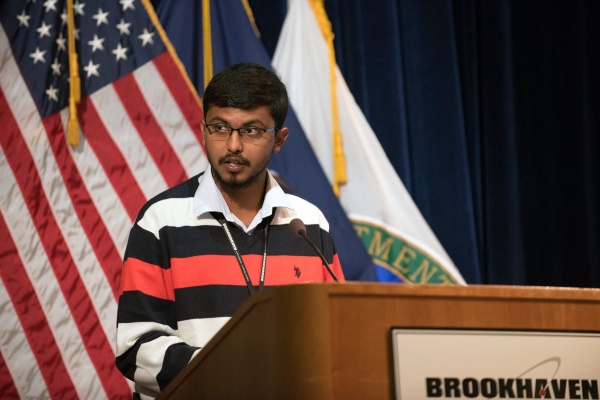Difference between revisions of "Dhananjay Ravikumar"
From CASE
| (4 intermediate revisions by the same user not shown) | |||
| Line 1: | Line 1: | ||
[[Image:DJ.jpg|600px|Image: 600 pixels|center]] | [[Image:DJ.jpg|600px|Image: 600 pixels|center]] | ||
| − | + | ==Project: '''Cryogenic studies for the Electron Ion Collider at BNL (or eRHIC)''' == | |
| − | * '' | + | * ''Affiliation'': Collider-Accelerator Department (C-AD) in Brookhaven National Lab (BNL) and Department of Mechanical Engineering in Stony Brook University (SBU) |
| − | + | ||
| − | + | * ''Supervisor(s)'': Yatming (Roberto) Than (BNL) and Jon Longtin (SBU) | |
| − | * '' | + | * ''Project description'': Components of the accelerator that connect directly to the 2 K volume induce additional thermal loads on the cryogenic system. As a result, mapping temperature distributions and heat flow along these structures play a prominent role in engineering a feasible design for the system. My current project focuses on estimating thermal loads from the warm end of the beam tube, which undergoes a transition from room temperature of 300 K to 2 K in the short space of half a meter. Thermal radiation is thus no longer negligible and is coupled with the solution to the conduction problem with the temperature distributions and geometry dictating what fraction of radiation reaches the cold end. The conclusion of the study will, along with simplified analytical calculations, give us an accurate picture of the physics, allowing us to make informed decisions on the design. |
| − | + | ||
| − | + | ==About me== | |
| − | + | *Bachelor’s degree: Mechanical Engineering, SASTRA University, India (2007-2011) | |
| − | + | *Master’s degree: Theoretical Physics, Specialization: Particle Physics, University of Glasgow (2011-2012) | |
| − | + | *Professional Fields of interest: Cryogenics, Computational Fluid Dynamics and Heat Transfer, Thermodynamics. | |
| + | *Personal fields of interest: Professional Basketball (2007-2011), soccer, swimming and volleyball enthusiast. | ||
| + | *Hobbies: Beginner guitarist and drummer. | ||
Latest revision as of 19:36, 13 March 2017
Project: Cryogenic studies for the Electron Ion Collider at BNL (or eRHIC)
- Affiliation: Collider-Accelerator Department (C-AD) in Brookhaven National Lab (BNL) and Department of Mechanical Engineering in Stony Brook University (SBU)
- Supervisor(s): Yatming (Roberto) Than (BNL) and Jon Longtin (SBU)
- Project description: Components of the accelerator that connect directly to the 2 K volume induce additional thermal loads on the cryogenic system. As a result, mapping temperature distributions and heat flow along these structures play a prominent role in engineering a feasible design for the system. My current project focuses on estimating thermal loads from the warm end of the beam tube, which undergoes a transition from room temperature of 300 K to 2 K in the short space of half a meter. Thermal radiation is thus no longer negligible and is coupled with the solution to the conduction problem with the temperature distributions and geometry dictating what fraction of radiation reaches the cold end. The conclusion of the study will, along with simplified analytical calculations, give us an accurate picture of the physics, allowing us to make informed decisions on the design.
About me
- Bachelor’s degree: Mechanical Engineering, SASTRA University, India (2007-2011)
- Master’s degree: Theoretical Physics, Specialization: Particle Physics, University of Glasgow (2011-2012)
- Professional Fields of interest: Cryogenics, Computational Fluid Dynamics and Heat Transfer, Thermodynamics.
- Personal fields of interest: Professional Basketball (2007-2011), soccer, swimming and volleyball enthusiast.
- Hobbies: Beginner guitarist and drummer.
